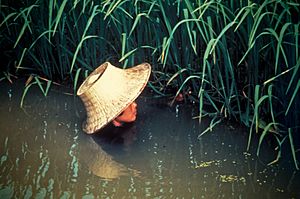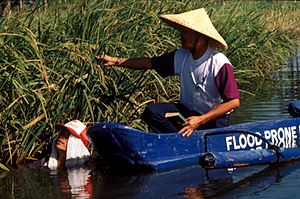Deepwater rice facts for kids
Deepwater rice is a special kind of rice that grows in flooded areas. It can survive in water that is more than 50 cm (20 in) (about 20 inches) deep for at least a month! This type of rice is super important for over 100 million people in places like Southeast Asia and Northeastern India, as it's a big part of their food supply.
There are two main ways deepwater rice handles deep water:
- Traditional Talls: These rice plants grow taller and have longer leaves than regular rice. They can grow in water that is between 50 and 100 cm (20 and 39 in) deep.
- Floating Rice: This type grows in water deeper than 100 cm (about 40 inches). It has an amazing ability to grow super fast when the water level rises. This means its stem stretches quickly, helping the plant's leaves stay above the water.
Most deepwater rice varieties come from a type called O. s. indica. Some O. s. japonica varieties are also found in places like Myanmar and Assam.
Contents
Where Deepwater Rice Grows
Deepwater rice is a very important food source, grown on about 90,000 km2 (35,000 sq mi) of land. That's a huge area! Most of it is grown in Southeast Asia, especially in Northeastern India.
In South-East Asia, you'll find a lot of deepwater rice in the Brahmaputra valley in Assam, India. It's also grown in Myanmar (in the Irrawaddy Delta), Thailand (in the Chao Phraya area), and along the Mekong River in Vietnam and Cambodia. In these countries, deepwater rice makes up more than 25% of all the land used for growing rice.
Deepwater rice is also grown in West Africa, though not as much as in Asia. About 4,700 km2 (1,800 sq mi) of it grows there, especially around the Niger River. You can even find some deepwater rice farms in Ecuador!
How Deepwater Rice is Grown
Deepwater rice usually grows in places with a tropical monsoon climate, which means they get a lot of rain. These areas are often near river deltas and their floodplains, like in low-lying backswamps or natural levees.
The way the water floods is very important for deepwater rice to grow well. The timing of the flood and how fast the water rises can affect if the plants survive and how many grow. Usually, the floodwater comes from heavy rainfall or from the water table rising. In drier areas, rivers overflowing can also flood the rice fields.
Challenges for Deepwater Rice
Growing deepwater rice can be tricky because of a few problems:
- Drought: If the seeds are planted directly into the soil, they can get damaged by dry weather before the floods arrive.
- Weeds: Young rice plants can also struggle because of too many weeds growing around them.
- Sudden Floods: If a lot of water rushes into the field very quickly, many young rice plants might die.
Floating rice, which grows in very deep water, faces even more challenges. Things like strong water currents (called turbulence) and water temperature can harm the crop.
Natural disasters can also cause big problems. Tropical cyclones are a major threat in Asia. For example, in 2008, a storm called Cyclone Nargis destroyed over 122,000 hectares of deepwater rice in Myanmar. Also, if sea levels rise because of climate change, it could change how floods happen, making them deeper and covering more land.
Even with these challenges, deepwater rice is good for the environment in one way: it produces less methane gas than other types of wetland rice. Methane is a greenhouse gas, and deepwater rice creates only about one-third of the methane that regular paddy field rice does.
How Floating Rice Adapts to Floods
Floating rice is planted in dry ground first, allowing the young plants to grow a bit. When the area floods, it triggers the rice's special "elongation ability." This means the plant's stem grows super fast, especially in the parts between the joints (called internodes). This rapid growth helps the plant keep its foliage above the water. The stems are hollow, which lets the plant exchange gases with the air.
Once the flooding stops, the plant might be lying flat on the ground. But don't worry! The top parts of the plant will start growing upwards again towards the sky. This is because plants are sensitive to gravity, a process called gravitropic sensitivity.
The amazing rapid growth is triggered by a gas called ethylene. Plants naturally produce ethylene, and it usually spreads into the air. But when floating rice is underwater, the gas can't escape easily, so it builds up inside the plant. This buildup of ethylene then tells the plant to make another hormone called gibberellin, which causes the stem to grow very quickly. Once the plant reaches the water surface, the ethylene can escape normally, and the fast growth stops. Scientists are still working to make rice even better at handling deeper water, because if it stays underwater for too long, it can "drown."
New Kinds of Deepwater Rice
Scientists have developed new types of deepwater rice that are even tougher. One new kind is called Swarna Sub1. It was created using a special method called marker-assisted selection. This rice can survive being completely underwater for about 14 days!
This amazing ability comes from a special gene called Sub1A. Scientists took this gene from an Indian rice variety called FR13A and put it into a popular, high-yielding rice called Swarna, which usually doesn't do well in floods.
When Swarna Sub1 rice gets submerged, it goes into a kind of "sleep mode" to save energy. It carefully controls its metabolism and the activity of enzymes like amylases, starch phosphorylase, and alcohol dehydrogenase. This helps the plant survive with very little oxygen and sunlight, unlike its regular relatives.
The best part is that having the Sub1A gene doesn't change how good the rice tastes or how much rice is produced. Because of this, Swarna Sub1 has become very popular. In India, about 1.7 million hectares of land now use Swarna Sub1 and other flood-resistant rice varieties instead of older, less resilient types.



